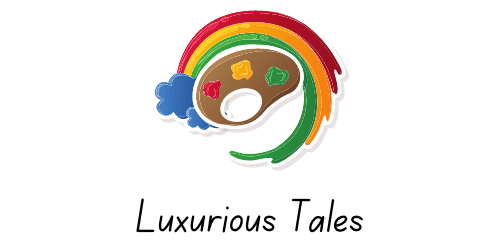Victorian interior design is hailing from the 19th-century era of Queen Victoria, is a style known for its luxury and intricacy.
It showcases a rich tapestry of dark, luxurious colors, intricate patterns, and abundant decorative elements like ornate woodwork, intricate plaster mouldings, and lavish textiles.
Furniture in this style is typically substantial and embellished, reflecting a deep emphasis on craftsmanship. The enduring allure of Victorian interior design lies in its ability to transport us to a bygone era of opulence and grandeur.
This captivating style, rooted in a fascination with history, inspires modern interiors with its romantic and lavish aesthetic.
Its distinctive charm can be seamlessly integrated into contemporary spaces, allowing us to relish the timeless elegance and exquisite detailing that define Victorian design.

Source Pinterest
What is Victorian Interior Design?
Victorian interior design is a distinctive and opulent style that emerged during the reign of Queen Victoria in the 19th century.
This ornate and elaborate design aesthetic draws inspiration from the Victorian era, characterized by a fascination with history and a blend of various design elements.
Victorian interiors often feature rich, dark colors, intricate patterns, and a profusion of decorative details like intricate woodwork, plaster moulding, and elaborate textiles. Furniture is often heavy and embellished, reflecting the era’s emphasis on craftsmanship.
Overall, the Victorian interior design exudes a sense of luxury and nostalgia, creating a sumptuous and sophisticated ambience that returns to a bygone era of opulence and grandeur.
Victorian Interior Design
1: Dinner Elegance
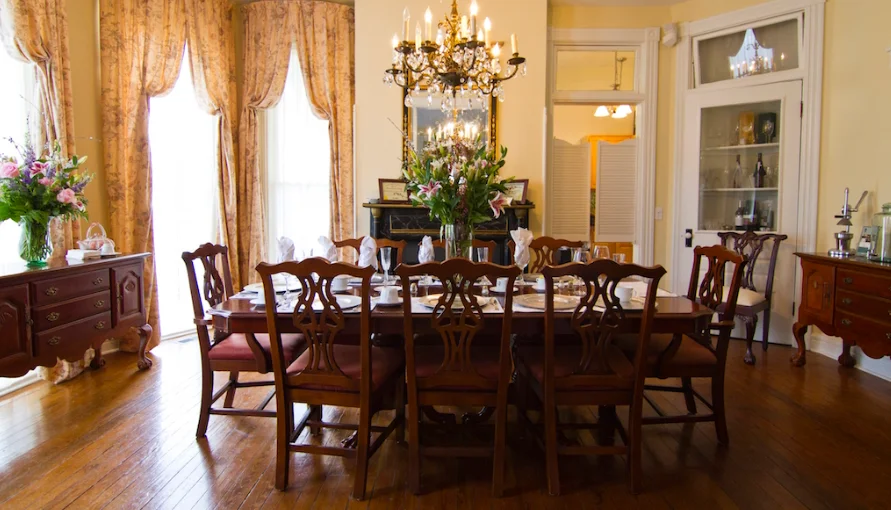
Source Pinterest
The combination of blue and beige is a classic color scheme, and it lends a touch of elegance to this dining room decorated in the Victorian style.
Concentrating more on basic elegance with elaborate patterns makes this space so welcoming, particularly when it’s time for the family to gather and spend quality meal time together. It is especially important to remember when it comes to the dining table.
2: Fired Up

Source Pinterest
You can transform a standard fireplace into an elaborate piece of artwork with a Victorian theme by just surrounding it with anything you can find that will give the impression that this feature of your house has travelled through time and brought back some souvenirs to brighten the inside of the room.
3: Restroom Beauty
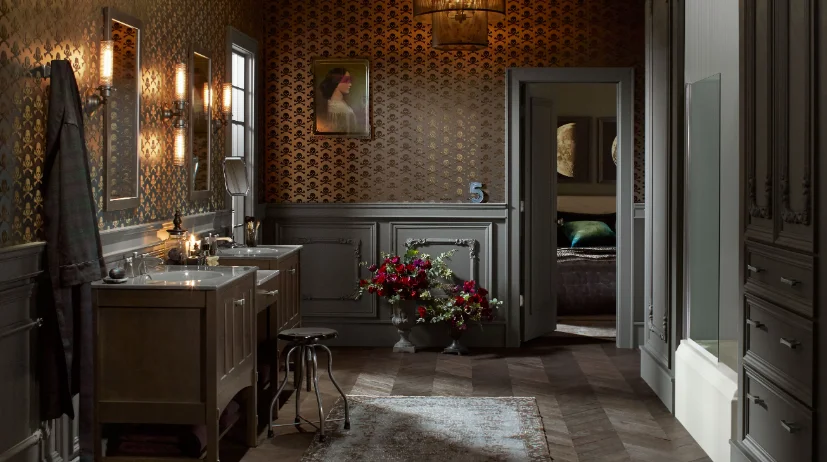
Source Pinterest
Why should using the restroom be such a dull experience? Why not spice it up with a Victorian antique sink and use the mirror to make the area look bigger than it is?
The Victorian era was known for its fondness for ornateness and meticulous attention to detail, and as a result, the period’s large art collection was highly prized.
Bringing all of it to life can make the inside of the whole house seem like a masterpiece created by an artist. It is a stunning example of a concept for interior decor.
4: Collection Deserving of Praise

Source Pinterest
Even if you decorate one wall the room with your Victorian-themed collection, you will notice a significant improvement in the space’s aesthetic appeal. It takes a little effort to transform a plain wall into a wonderful exhibition of art and history in a way that contributes to the success of this home design.
5: Victorian Gothic
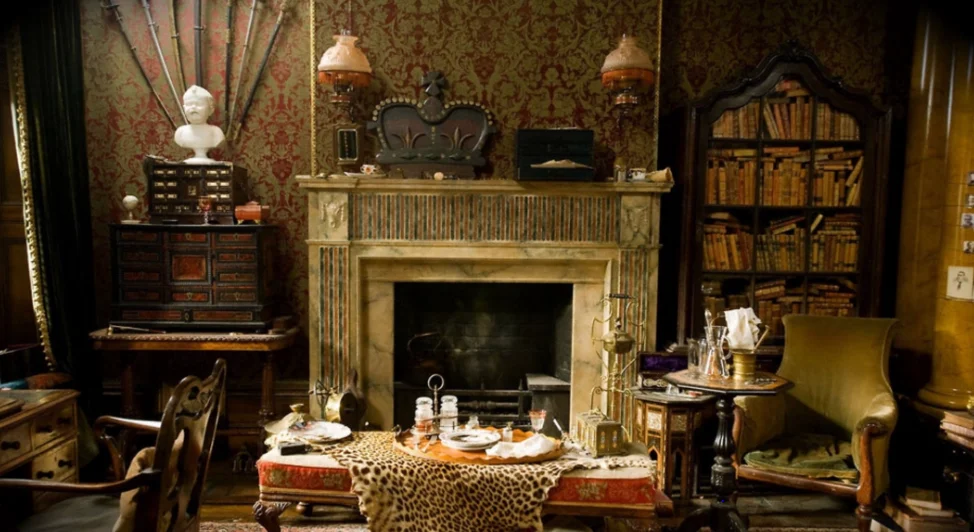
Source Pinterest
Gothic and Victorian eras are characterized by a strong focus on minute details and the manipulation of color, two characteristics that link the two periods.
The combination of red, black, and brown is nothing short of magnificent, as are the exquisite patterns in the glass work, embroidery, and paintwork. Also, remarkable is the mix and match between red, black, and brown colors.
6: Stunningly Majestic
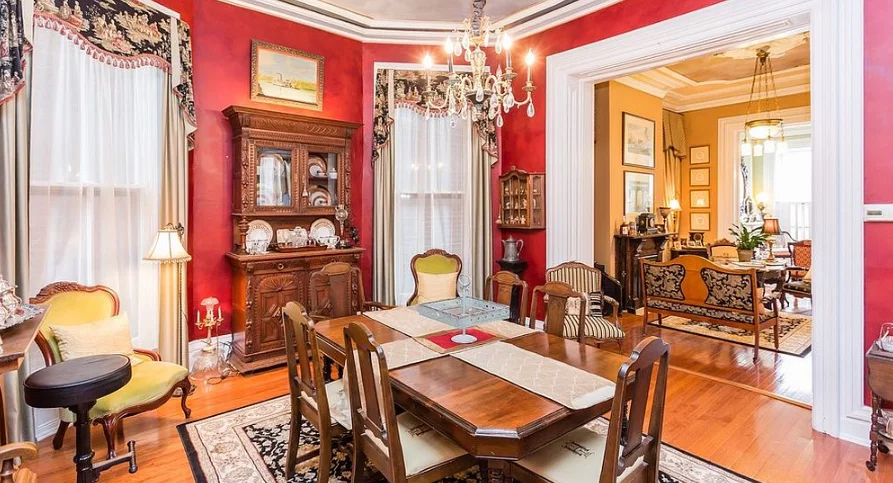
Source Pinterest
The emphasis on adorned particulars throughout the Victorian era contributed to widespread popularity. The fact that this bedroom may easily belong to royalty inspires a need to elevate one’s life from the mundane to the remarkable.
If money were no problem, creative people worldwide would go out to construct the perfect dream bedroom in the Victorian style.
As long as the theme was maintained, there would be no limits to how far they would go to achieve this goal.
7: Kitchen in the Victorian era
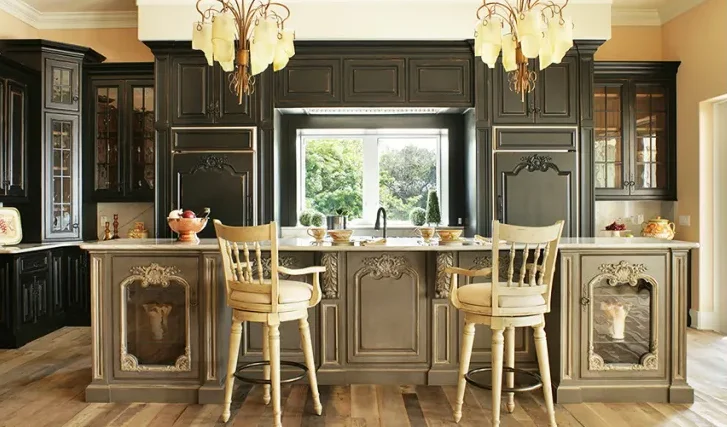
Source Pinterest
It is still feasible to date a kitchen into the Victorian period and yet get away with it, even though we have all the pleasures of modernity at our fingertips.
It works because of the combination of white, blue, and brown for the color scheme and the presence of a casual eating space. Since 1820, this particular combination of colors was very popular and was used often.
8: Animated by Inn Spirits
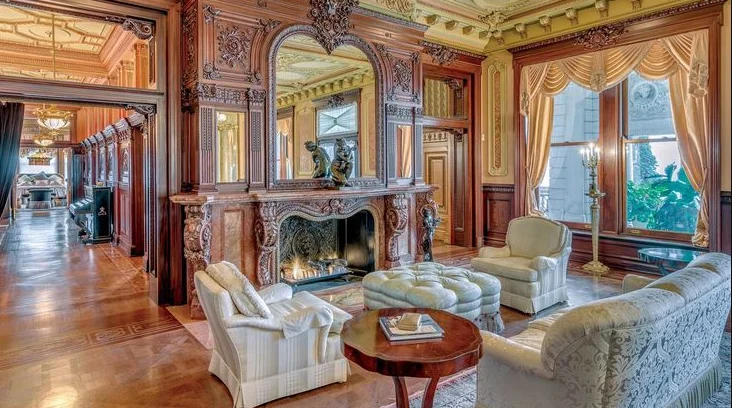
Source Pinterest
There is a good reason why the interior decor of many of the most well-known bed and breakfast places tends to be heavily influenced by Victorian-era styles.
When you are in a setting that strongly emphasizes the minute particulars, you have a heightened sensation of romanticism.
Whether on a honeymoon or a simple break to celebrate an anniversary, having a bedroom decorated as if it was taken from a travel magazine, including a charming little in can do so much to convert a mundane bedroom into an extraordinary piece of art.
It can be done by having the bedroom designed as if borrowed from a travel magazine containing a cute little in.
9: The Steampunk Style

Source Pinterest
The age of the Victorian era served as an inspiration for the literary subgenre known as Steampunk, which has become a cult favorite all over the globe for a good cause.
In addition to the room’s interior design, which is themed after the Victorian era, an odd top hat adds a sophisticated touch to the space, creating an atmosphere that combines the most appealing aspects of the two eras without going overboard.
10: Potted
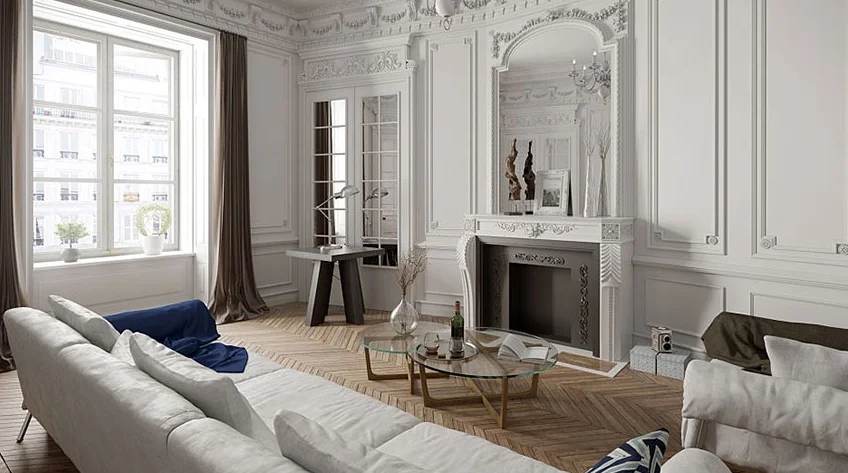
Source Pinterest
There’s something special about those antique stoves, with their iron structures that were originally used to light some wood on fire and then utilize the resulting heat as a source of cooking.
The adaptability of a device that was seen to be a brilliant innovation before electrical stoves became a standard item in most households around the beginning of the twentieth century is shown by the fact that it can be used to either heat the water for beverages such as coffee or tea or else do one of the following: it may be used to cook a meal.
Some Important Parts of the Look
There are a few important parts to the interior style of a Victorian house:
- The architecture of Victorian dwellings was meant to be aesthetically pleasing and practical.
- Stained-glass windows, elaborate woodwork, and sumptuous upholstery were often seen in Victorian-era residences.
- The key to successfully designing the inside of a Victorian home is to create a consistent and elegant design.
- Give careful attention to the details and use high-quality materials if you want your property to have a Victorian appearance.
Some Architectural Parts
Industrial-style architecture is distinguished by its practical aesthetics and minimalist design.
Prominent features of industrial-style architecture include exposed structural elements, large windows, and open spaces.
Materials frequently found in industrial-style buildings comprise steel, concrete, and glass.
Industrial-style interiors often showcase raw materials and straightforward, functional furnishings.
How to Make an Inexpensive Victorian Look?
Creating a Victorian look on a budget:
Color Palette: Choose rich, deep colors like burgundy, forest green, or navy for walls and furnishings.
Finds from the Past Go to secondhand shops and flea markets searching for furniture and decorative items in a Victorian design.
Wallpaper: Opt for Victorian-inspired wallpaper, using it as an accent wall for a touch of luxury.
Ornate Frames: Frame artwork and mirrors with ornate, gilded frames for an authentic Victorian touch.
Textiles: Incorporate Victorian-style fabrics, like damask or velvet, for curtains, upholstery, and throw pillows.
Antique Lighting: Hunt for antique chandeliers or lamps to add elegance to your space.
Moulding: Install faux crown moulding or chair rail to mimic Victorian architectural details.
Accessories: Add Victorian knick-knacks like cameo brooches, lace doilies, or vintage figurines.
DIY Projects: Consider DIY projects to refurbish and repurpose existing furniture into Victorian-style pieces.
Attention to Detail: Focus on intricate details and patterns to capture the essence of Victorian design without breaking the bank.
Victorian Patterns
Victorian patterns encompass a wide array of ornate and intricate designs that were prevalent during the Victorian era (19th century). These patterns are distinguished by their intricate motifs, including florals, geometric forms, scrolls, or even features inspired by lace.
Common Victorian patterns are often found on textiles, wallpapers, and architectural details. They reflect the era’s fascination with romanticism and historical revival, showcasing luxury and attention to detail.
These patterns continue to influence modern house interior design, fashion, and decorative arts, adding timeless elegance and nostalgia to contemporary settings.
What About Wall Decoration?
In Victorian-style homes, wall decoration frequently revolves around wallpaper. Typical Victorian wallpaper designs encompass damask, stripes, and floral patterns.
It was customary to adorn all four room walls in the Victorian era with wallpaper. In contemporary interior design, wallpaper is employed more selectively, often as an accent on one wall.
Another characteristic feature of Victorian homes is wainscoting, a wooden panelling covering the wall’s lower section. While traditionally crafted from wood, wainscoting can also be fashioned from materials such as plaster or tile, adding to the distinctive charm of Victorian-style interiors.
What Colors are Typical of Interior Design in the Victorian Era?
Victorian interior design is renowned for its opulent color palette, featuring rich and sumptuous hues that exude luxury and nostalgia. Common colors indicative of Victorian interiors include deep burgundy, Royal Navy, forest green, and rich gold.
These bold and dramatic shades are often paired with neutral tones like cream, beige, or ivory to create a harmonious contrast.
The Victorian era’s fascination with nature is reflected in colors like olive green and terracotta, while dark wood finishes and ornate gilded accents further enhance the overall amenity of this timeless design style.
Victorian vs. Edwardian Interior Design
Victorian and Edwardian interior designs hail from distinct historical eras but differ. Victorian-era design features deep, rich colo
rs, creating a sense of luxury.
On the other hand, Edwardian design, popular during the Edwardian era, leans towards lighter and brighter color schemes. So, while Victorian interiors revel in darkness and richness, Edwardian interiors opt for a more airy and luminous ambience, setting them apart color palettes and overall aesthetic.
What Victorian Furniture Accessories Should you Use?
Accessorizing Victorian Furniture
Incorporating Victorian furniture into your decor brings a touch of timeless elegance. Common Victorian pieces include sofas, chairs, and chaises, often distinguished by claw foot legs, tufted upholstery, and intricate woodwork.
To enhance the Victorian look, complement your furniture with accessories like Victorian-style picture frames, vases, and other decorative items.
The Allure of Victorian Design
From before Queen Victoria’s reign in 1837 to the early 20th century, the Victorian era boasted intricate design schemes characterized by meticulous detail.
This period’s influence extended throughout the 19th century, shaping interiors and exteriors.
Victorian design’s enduring appeal continues to captivate decorators, reminiscent of the elegance seen in the Gothic Era of the 12th century and the Renaissance of the 15th century.
Victoria’s reign left a remarkable design legacy, with its global impact stretching from 1820 to 1914, making it a cherished and timeless era in design history.
